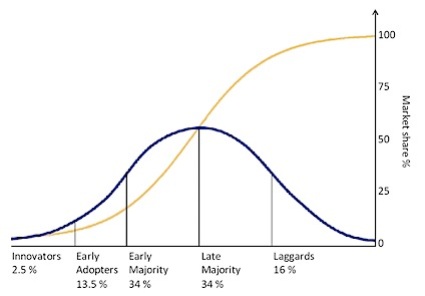 by davidgsteadman
by davidgsteadman
Will anyone be able to compete with Apple’s revolutionary iPad?
[Via MacDailyNews]
“If you want to buy a consumer-friendly tablet computer today and you don’t want to purchase Apple’s iPad, you’re pretty much out of luck,” John D. Sutter reports for CNN.
[More]
The inability of the computer industry to match what Apple has done over the last 30 years is simply amazing. Apple continues to see where the market is moving and then leaps ahead of its competitors to define the market, rather than simply follow it.
As this post mentions, Jobs and Apple have defined the personal computer interface three and maybe four times – Apple II, Mac, OS X and iPhone/iPad. At each stage, the interaction between the user and the computer became more intuitive and easier.
Apple also defined much of the way computers looked – Apple II, Mac, Powerbook, iMac, iPhone/iPad. Not only have they been largely responsible for how we interact with a computer, they have defined how computers look.
People have been talking about selling tablets for 6 or 7 years. Yet here Apple is again, not only defining the market but selling a ton of the devices, leaving everyone else to try and catch up to something that they really have no clue about.
Why has no one else been able to do that in 6 years? How was Apple able to essentially create a new market?
Apple has always had the unique ability to take something really complex – the creation of a computational device that people can use – and find a way to simplify it. It takes a lot of hard work to accomplish this, but also an ability to manipulate really complex ideas in ways that few organizations are capable of.
Watching other organizations try and define this is like watching blind men describe an elephant – it must be the light weight; it must be the touch screen; it must be the apps. None of them understand how to present a complex device that requires innovation at all stages, not just one.
It requires the creation of an organization that can synthesize large amounts of information and make wise decisions.
Just think what the world would be like if Apple had not existed? I would nominate Jobs for man of the last half century. Not merely because of his individual abilities – which are prodigious – but because he has also been able to leverage the mass creativity of his employees.
One important aspect of all the organizations that Jobs has been associated with is the large number of named individuals that are found in the development of any of the innovations.The names of the Mac developers for Apple are well known. Same at NeXt or at Pixar.
The actual people involved in much of the innovative changes are given their recognition.The Wikipedia article about the Mac lists over 15 people, all with links, who were involved in the development of the computer. The one on the development of Windows lists not a single name.
Coincidence?
Read about the days of the development of the Mac and you see a group of wildly creative people solving difficult problems. Read about NeXT, where Jobs experimented with corporate organization as much as he did with computer programming, or simply observe what happened with a company like Pixar, where the creative geniuses were able to create an entirely new art form using computers, leapfrogging ahead of all their competitors.
The ability to take a core group of creative individuals and harness them to an awesome task is not easy. I wrote about this is a series on Synthetic Organizations – Part 1, Part 2 and Part 3.
Marty Baker at Creativity Central broke down some of the principles seen at Pixar and also can be seen at Apple:
Pixar’s Operating Principles can be distilled down to 3 principles.
1. Everyone must have the freedom to communicate with anyone.
2. It must be safe for everyone to offer ideas.
3. We must stay close to innovations happening in the academic community.
In the Innovator’s Dilemma, Clayton Christensen discusses the difficulty organizations have in utilizing disruptive technology in novel ways. The dilemma is that often the same processes that helped make them successful now prevent them from making the leap to a new technology set. See Clay Shirky’s article on the collapse of business models for some examples.
Even when they know that they have to change and even what the changes must be, they almost always fail in making the leap.
That is mainly in the way they are organized, how they are run and the types of communities they represent.
Yet companies that have Steve Jobs organizing them seem to have been able to do this. Apple defined personal computing, it defined the graphic user interface, the laptop, the MP3 player, the smartphone, the tablet computer. Pixar defined computer generated animation.
By creating organizations where innovations are not shuttled through layers of middle management, with each layer sucking the originality out, Jobs has been able to drive disruptive innovations rather than react to them.
The most amazing thing to me is that Apple has succeeded in being a market leader during two separate paradigm shifting market wars – first the graphical user interface wars between Apple vs Microsoft and now the Internet as interface wars between Apple vs Google. Microsoft’s inability to become a major player in the new way of the world is an example of corporations failing to make the leap, of suffering the Innovator’s Dilemma.
Yet Apple is right there, leading the way as the market makes another decision about the future course of computing. Apple may not win but the course it charts drives decisions in ways that no other company of the last half century has.
Now the market must find ways to respond, to be more innovative than Apple.
Without Apple driving the industry to be creative – how in the hell do we keep up with Apple – we would not be where we are today. It makes one wonder where we would be if Jobs had not been forced out at Apple by a sugar-water salesman. We may only just now have gained where we would have been without those 10 lost years.
 by NeoGaboX
by NeoGaboX





